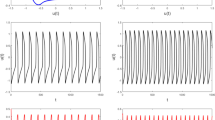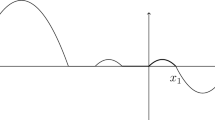Abstract
The paper investigates the spatio-temporal structures arising in the distributed model of the NO+CO/Pt(100) reaction. Different types of spatio-temporal structures are identified. Their existence domains are plotted on a bifurcation diagram in the (T, P) parameter plane for a fixed pressureP. Spatio-temporal structures are investigated in excitable and bistable media, such as single traveling pulses and switching waves. Spatio-temporal chaos is shown to exist in a fairly wide range. The system is highly sensitive to initial conditions, which confirms its complex chaotic behavior. It is shown that the new reaction-diffusion model describes the basic features of experimental observations. This model also predicts some interesting phenomena, such as formation of localized pulses (both stationary and breathing), that so far have not been observed experimentally.
Similar content being viewed by others
References
A. Yu. Loskutov and A. S. Mikhailov, An Introduction to Synergetics [in Russian], Moscow (1990).
H. Shyldkrot and J. Ross, “Propagating and stationary structures in chemical reaction-diffusion systems,” J. Chem. Phys.,82, No. 1, 113–122 (1985).
M. Faicke, M. Bar, H. Engel, and M. Eiswirth, “Traveling waves in the CO oxidation on Pt(110): Theory,” J. Chem. Phys.,97, No. 6, 4555–4563 (992).
M. Bar, Ch. Zulicke, M. Eiswirth, and G. Ertl, “Theoretical modeling of spatio-temporal self-organization in a surface catalyzed reaction exhibiting bistable kinetics,” J. Chem. Phys.,96, No. 11, 8595–8604 (1992).
A. Hagberg and E. Meron, “Pattern formation in non-gradient reaction-diffusion systems: the effects of front bifurcations,” Nonlinearity,7, 805–835 (1994).
C. B. Muratov, “Synchronization, chaos, and the breakdown of collective domain oscillations in reaction-diffusion systems,” Phys. Rev. E,55, No. 2, 1463–1477 (1997).
A. Doelman, T. J. Kaper, and P. A. Zrgeling, “Pattern formation in the one-dimensional Gray-Scott model,” Nonlinearity,10, 523–563 (1997).
V. N. Snytnikov, “Isolated traveling waves in a heterogeneous medium with chemical reactions,” Fizika Goreniya i Vzryva,34, No. 3, 29–35 (1998).
G. Veser and R. Imbihl, “Synchronization and spatio-temporal self-organization in the NO+CO reaction on Pt(100), 1: Unsynchronized oscillations on the 1×1 substrate,” J. Chem. Phys.,100, No. 11, 8483–8491 (1994).
E. S. Kurkina and A. G. Makeev, “Bifurcation analysis of a mathematical model of the NO+CO/Pt(100) reaction,” in: Inverse Problems in Natural Sciences [in Russian], MGU (1992), pp. 52–78.
R.-S. Li and W. Horsthemke, “Effects of product occupancy on self-organization in heterogeneous catalysis. Spatial pattern formation,” J. Chem. Phys.,96, No. 2, 1549–1555 (1992).
A. G. Makeev, N. M. H. Janssen, P. D. Cobden, M. M. Slinco, and B. E. Nieuwenhuys, “Study of spatial pattern formation during the NO+H2/Rh(111) reaction by means of mathematical modeling,” J. Chem. Phys.,107, No. 3, 965–978 (1997).
E. S. Kurkina and A. V. Malykh, “Investigation of Turing instability in four-component mathematical model of the NO+CO/Pt(100) reaction,” Proc. Conf. Mathematics, Computers, Education [in Russian] (1998), pp. 169–176.
M. C. Cross and P. C. Hohenberg, “Pattern formation outside of equilibrium,” Rev. Mod. Phys.,65, 851 (1994).
M. Argentina and P. Coullet, “A generic mechanism for spatio-temporal intermittency,” PhysicaA257, 45–60 (1998).
M. Meixner, S. Bose, and E. Scholl, “Analysis of complex and chaotic patterns near a codimension-2 Turing-Hopf point in a reaction-diffusion model,” Physica,D109, 128–138 (1997).
J. H. Merkin, V. Petrov, S. K. Scott, and K. Showalter, “Wave-induced chaos in a continuously fed unstirred reactor,” J. Chem. Soc. Faraday Trans.,92(16), 2911–2918 (1996).
T. Fink, J.-P. Dath, M. R. Basset, R. Imbihl, and G. Ertl, “The mechanism of the ‘explosive’ NO+CO reaction on Pt(100): experiments and mathematical modeling,” Surf. Sci.,245, 96–110 (1991).
T. Fink, J.-P. Dath, R. Imbihl, and G. Ertl, “Kinetic oscillations in the NO+CO reaction on Pt(100): experiments and mathematical modeling,” J. Chem. Phys.,95, 2109–2118 (1991).
A. G. Makeev, “A mathematical model of the NO+CO/Pt(100) reaction. Comparison of theoretical results with experimental data,” Matem. Modelirovanie, No. 2, 115–127 (1996).
R. Monot, M. Croci, and B. Calpini, “Chemisorption and surface diffusion on model catalyst surfaces: molecular beam studies,” Analysis Mag.,21, No. 8, 28–35 (1993).
V. V. Osipov, “Criteria of spontaneous interconversions of traveling and static arbitrary dimensional dissipative structures,” Physica,D93, 143–156 (1996).
C. B. Muratov and V. V. Osipov, “Scenarios of domain pattern formation in a reaction-diffusion system,” Phys. Rev. E,54, No. 5, 4860–4879 (1996).
Additional information
The study has been partially supported by the Russian Foundation of Basic Research (grant 97-01-01093).
Translated from Chislennye Metody i Vychislitel'nyi Eksperiment, Moscow State University, pp. 44–63, 1998.
Rights and permissions
About this article
Cite this article
Kurkina, E.S., Malykh, A.V. & Makeev, A.G. Natural waves and chaotic structures in a distributed four-component model of the NO+CO/PT(100) reaction. Comput Math Model 10, 363–378 (1999). https://doi.org/10.1007/BF02359087
Issue Date:
DOI: https://doi.org/10.1007/BF02359087




